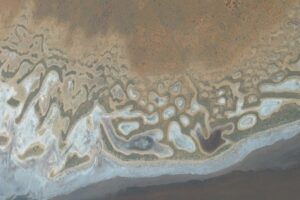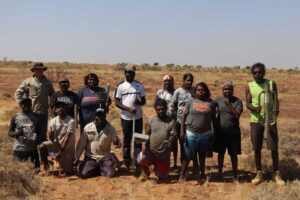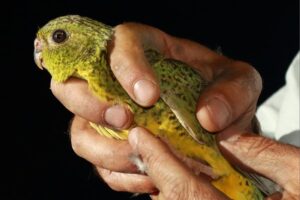Night parrot located by KJ rangers on Martu country in the Pilbara
Karen Michelmore and Laura Birch
ABC Pilbara
The elusive night parrot has been found in Western Australia’s remote salt lake country.
(Supplied: Steve Murphy)
Rangers in Western Australia’s remote northern salt lake country have found one of the world’s most elusive birds, which was once thought extinct.
For two years, the Martu people’s Kanyirninpa Jukurrpa (KJ) rangers, working alongside experts from the University of Queensland, placed five sound recorders in pockets of the sparse Pilbara desert, searching for any sign – or sound – of the endangered night parrot, Pezoporus occidentalis.
An analysis of the data by the university’s Stephen Murphy and PhD student Nick Leseberg confirmed the bird’s call at two locations on Martu country.
“It’s very exciting news,” KJ’s healthy country officer Daniel Johanson said.
“The rangers are thrilled about it.
“[I] called up the rangers and gave them the news, and there was a lot of applause and a few fist pumps and the rest of it.
“People were pretty happy to hear that their hard work had paid off.”
It is the fifth confirmed location of the bright green, ground-feeding bird in WA.
Most have been found in salt lake systems.
This salt lake is a favoured haunt of night parrots.
(Supplied: KJ rangers)
A pretty mysterious bird
Mr Johanson said not a lot was known about the night parrot, because it had “disappeared off the radar” for decades.
“In the 1920s through to the 1990s there were no live records,” he said.
“There was a couple of dead ones found, but it used to be quite widespread in the arid zone, but it contracted pretty dramatically.
“There’s not a lot known about it because nobody’s really been able to study it for most of that period.”
Mr Johanson said there had been some finds in recent years, mostly at one area in Queensland.
KJ rangers with a sound recording device that was used to successfully locate a new night parrot population in remote Martu country.
(Supplied: KJ rangers)
“They are very good at hiding,” Mr Johanson said.
“They are very elusive little birds — they only come out after dusk and go to bed before dawn.
“They are low flying and stick to the ground.
“It’s like finding a needle in the haystack, so getting a couple of recordings is very exciting.”
The search continues
The Martu rangers are now preparing to extend their search to other salt lake systems in a bid to try and find roosting sites and see if they can identify other populations.
“We have to start to narrow down the area that we are looking in and try and pinpoint a little burrow in a big clump of spinifex somewhere out there, to find where they are nesting,” Mr Johanson said.
He said this was critical to try and ensure their protection from fire.
“Fire is a big threat to the night parrots, uncontrolled wild fire,” Mr Johanson said.
“The rangers already do a lot of prescribed burning on Martu country and a lot of fire management.
“But if we know exactly where they are roosting we can make sure we are protecting those areas from wildfires.”
The night parrot is so rare and so secretive that it has been known to go undetected for decades at a time.
(Supplied: Rachel Murphy)
Mr Johanson said the work showed the importance of having rangers with local knowledge and skills on country, who could work with scientists.
“You couldn’t probably get a conservation find like this without having them there,” he said.
The Martu rangers manage more than 14 million hectares of country in the Great Sandy and Little Sandy Deserts.
They help to manage populations of other threatened species such the greater bilby, the great desert skink, and the black-flanked rock wallaby.
KJ said it had recently confirmed the presence of the Pilbara leaf-nosed bat.
abc.net.au/news/elusive-night-parrot-discovered-in-the-pilbara/12581900
Posted 21 Aug 2020



